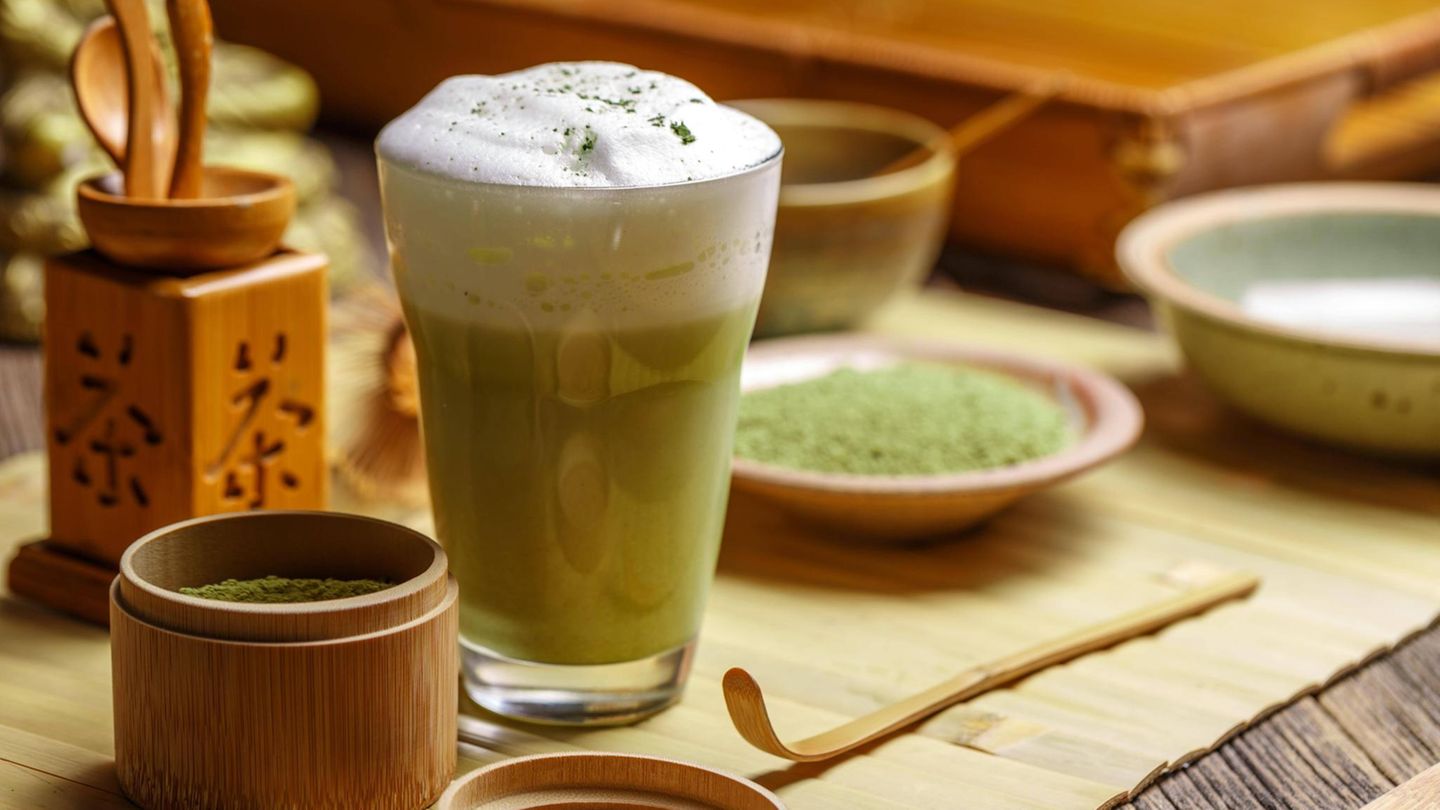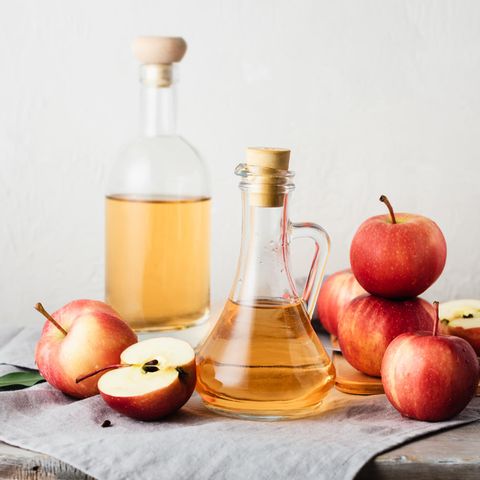Drink hype
Can matcha tea cause iron deficiency? What you should know about it
Copy the current link
Add to watchlist
Does matcha tea really cause iron deficiency? Concerned people and alleged experts are warning about the trendy drink online. But what is it? Plus: the best tricks against iron deficiency.
Disturbing pictures and videos are doing the rounds on social networks like Tiktok and Instagram: Women are supposedly in the hospital with an infusion or claim to have had an iron deficiency diagnosed through a blood test. People who introduce themselves as alternative practitioners or emergency paramedics warn of dangerous deficiency symptoms, allegedly caused by a popular drink: matcha green tea, also often drunk as a matcha latte. But what is behind the claims?
In principle, it is chemically correct that certain ingredients in green matcha inhibit iron absorption. But whether they really trigger a “dangerous” iron deficiency is questionable. You should be skeptical for several reasons: Firstly, the symptoms described online, such as fatigue, headaches, hair loss or brittle nails, are so unspecific that there could be many other causes such as stress, too little sleep or zinc deficiency. On the other hand, it is unclear how reliable over-the-counter self-tests that are supposed to prove an iron deficiency are. To do this, you have to take a certain amount of blood from your fingertip using a spike and drip it onto a test card. However, no doctor or laboratory can check whether you have done this correctly at home.
Matcha – what is it actually?
But what is actually in matcha tea? The popular drink is a foamy infusion made from finely ground green tea leaves. The plants are raised partially in the shade, especially in Japan, using a special method so that particularly large and delicate leaves are formed. They are steamed, dried and finely ground. According to Japanese tradition, the bright green powder is poured with water that is no longer boiling and the matcha is stirred with a bamboo whisk until foamy.
In contrast to normal green tea, the leaves of matcha are not strained, but rather drunk – which is why matcha is said to provide a particularly high amount of fiber, vitamins, trace elements and other healthy substances. This health image has created such a hype for the tart-sweet foam infusion that tea farmers in Japan and other countries are now barely able to keep up with cultivation and production. In addition to matcha bars in larger cities, there have long been numerous other products, from matcha chocolate to delicate green ice cream.
The fact that matcha is said to be so healthy is mainly due to the catechins it contains. These tannins from the polyphenol group have antioxidant, cell-protecting properties and inhibit inflammation. This brings with it the hope that green tea could prevent serious illnesses such as cancer or heart disease. Promising effects have so far been demonstrated in cell cultures and in animal experiments; studies on humans have at least shown a moderate reduction in blood pressure and cholesterol levels – although not in all studies. In any case, there is no convincing evidence as to whether green tea really prevents serious illnesses in humans.
Catechins in matcha tea bind iron
The catechins in green tea and matcha also inhibit the absorption of iron, which the body needs primarily for the blood pigment hemoglobin, which transports oxygen from the lungs to the organs. The body can store a small amount of iron as a reserve in the spleen, liver, muscles and bone marrow; we have to get the rest from food every day.
The German Society for Nutrition (DGE) recommends 16 milligrams per day for women who lose blood through menstruation, 27 milligrams per day during pregnancy and 14 milligrams per day after menopause. Men should get eleven milligrams a day – values that can be achieved through clever combinations of foods.
But around eight to twelve percent of Germans have an iron deficiency, and among Europe’s women of childbearing age it is said to be as high as 20 percent. Even without matcha tea, many people have a higher risk of an iron deficiency, possibly even a deficiency, with symptoms such as pallor due to anemia, fatigue or brittle hair and nails. These include children and young people in phases of rapid growth, women, especially if their menstrual periods are heavy, as well as pregnant and breastfeeding women, as well as people who are vegetarian or vegan and therefore consume little or no iron from animal products.
Many factors come into play when it comes to iron deficiency
To date, it is unclear whether matcha plays a major role as an individual cause of iron deficiency. There are a handful of case reports in which green tea fans had very low iron levels. But in larger observational studies, the connection between tea and iron was not so clear.
Many factors come into play in iron metabolism. Basically, iron from animal foods, primarily meat or liver, is particularly easily absorbed by the body. Things are more complicated with plant-based iron: although whole grain products, peas, beans and lentils also contain a lot of iron, it is bound to so-called phytates, which make absorption more difficult.
In addition, polyphenols from green tea, black tea and coffee bind iron in an insoluble form so that it is not absorbed in the intestine but is excreted. Oxalic acid, which is found in rhubarb, also binds iron. In addition, everyone reacts differently to a lack of iron: some people are good at mobilizing iron from stores in the liver and muscles, others perhaps not.
Instead of giving up your beloved matcha altogether out of concern, people with a higher risk of iron deficiency (such as women and everyone who is vegan or vegetarian) should pay particular attention to a good supply of iron. There are several tricks to achieve this:
- Vitamin C improves iron absorption from plant products, which can be achieved relatively easily with a glass of orange juice or fresh fruit with muesli or with a little lemon juice in pea or lentil soup.
- Foods containing lactic acid such as yogurt, sauerkraut or kimchi also increase the iron yield during digestion.
- Soaking and sprouting grains reduces phytate content, making the products release iron more easily.
- And if you drink matcha, green tea or coffee (especially with milk, whose calcium also binds iron), you should do so one to two hours apart from meals. This gives the body time to absorb iron before the polyphenols from the drinks pull it in.
- In addition, dietary supplements containing iron should only be taken if a deficiency has been diagnosed by a doctor and after consulting a doctor.
Source: Stern
I’m Caroline, a journalist and author for 24 Hours Worlds. I specialize in health-related news and stories, bringing real-world impact to readers across the globe. With my experience in journalism and writing in both print and online formats, I strive to provide reliable information that resonates with audiences from all walks of life.





